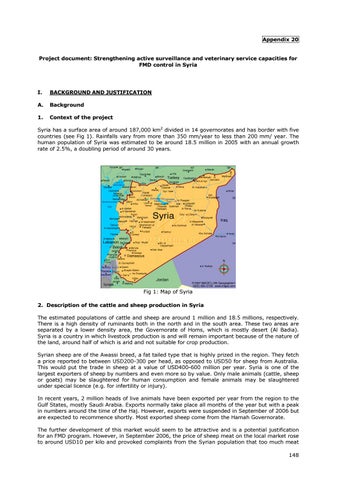Appendix 20
Project document: Strengthening active surveillance and veterinary service capacities for FMD control in Syria
I.
BACKGROUND AND JUSTIFICATION
A.
Background
1.
Context of the project
Syria has a surface area of around 187,000 km2 divided in 14 governorates and has border with five countries (see Fig 1). Rainfalls vary from more than 350 mm/year to less than 200 mm/ year. The human population of Syria was estimated to be around 18.5 million in 2005 with an annual growth rate of 2.5%, a doubling period of around 30 years.
Fig 1: Map of Syria 2. Description of the cattle and sheep production in Syria The estimated populations of cattle and sheep are around 1 million and 18.5 millions, respectively. There is a high density of ruminants both in the north and in the south area. These two areas are separated by a lower density area, the Governorate of Homs, which is mostly desert (Al Badia). Syria is a country in which livestock production is and will remain important because of the nature of the land, around half of which is arid and not suitable for crop production. Syrian sheep are of the Awassi breed, a fat tailed type that is highly prized in the region. They fetch a price reported to between USD200-300 per head, as opposed to USD50 for sheep from Australia. This would put the trade in sheep at a value of USD400-600 million per year. Syria is one of the largest exporters of sheep by numbers and even more so by value. Only male animals (cattle, sheep or goats) may be slaughtered for human consumption and female animals may be slaughtered under special licence (e.g. for infertility or injury). In recent years, 2 million heads of live animals have been exported per year from the region to the Gulf States, mostly Saudi Arabia. Exports normally take place all months of the year but with a peak in numbers around the time of the Haj. However, exports were suspended in September of 2006 but are expected to recommence shortly. Most exported sheep come from the Hamah Governorate. The further development of this market would seem to be attractive and is a potential justification for an FMD program. However, in September 2006, the price of sheep meat on the local market rose to around USD10 per kilo and provoked complaints from the Syrian population that too much meat 148





